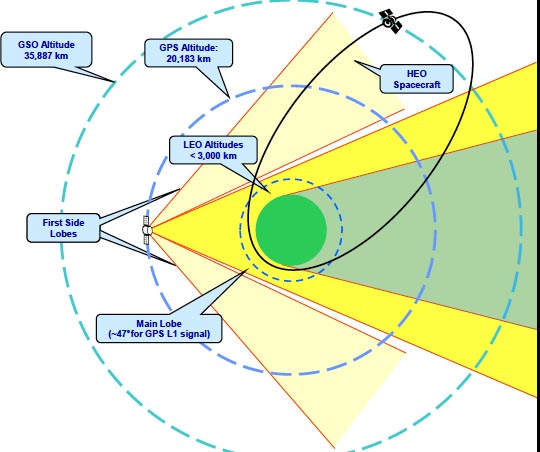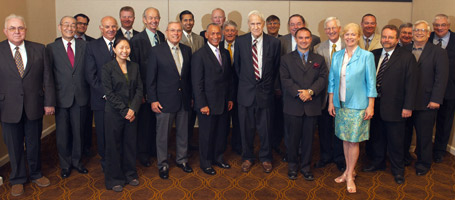The United States’ top advisors on satellite navigation are split over the practical implications of identifying the GPS system as critical infrastructure.
At the heart of the issue is the additional protection such a designation could potentially afford the constellation particularly in the arenas of public and congressional opinion. That protection, however, could come with another layer of time-consuming and possibly constricting bureaucratic requirements.
The United States’ top advisors on satellite navigation are split over the practical implications of identifying the GPS system as critical infrastructure.
At the heart of the issue is the additional protection such a designation could potentially afford the constellation particularly in the arenas of public and congressional opinion. That protection, however, could come with another layer of time-consuming and possibly constricting bureaucratic requirements.
The GPS system has been considered a “cross-sector dependency” for the Department of Homeland Security’s 16 designated critical infrastructure sectors for at least two years. DHS views 13 of the 16 critical infrastructures areas as critically dependent on PNT, explained board member Martin Faga, while the three remaining sectors had some dependence.
But the GPS constellation itself is not considered critical infrastructure — something the National Space-Based Positioning, Navigation, and Timing (PNT) Advisory Board has long recommended changing. Although that recommendation has languished without action by the PNT National Executive Committee (ExCom) for some time, 9 of the 25 board members still identified it as their top concern during the June board meeting.
“We felt the understanding and responses to threats to GPS would be better enhanced if it was recognized as critical infrastructure,” explained board Vice Chair Brad Parkinson. “Our recommendation was to designate it as critical infrastructure.”
Part of the hesitation has been concern over whether such a designation is actually helpful within DHS’s voluminous bureaucracy.
During a May 2013 board discussion of the issue, Jan Brecht-Clark, then-director of the National Coordination Office (NCO) for Space-Based PNT, told the advisory board that the idea had been discussed and set aside by the ExCom’s Executive Steering Group because GPS “actually permeates all of (the sectors) and needs to be raised across all of them.”
To counter continuing concerns it was suggested that the board ask for a creative new designation for GPS — critical enabling infrastructure, an approach Parkinson said might avoid some of the previous “rigmarole.”
“My hope is in so doing you would alert the rest of the federal government that any decision you make that potentially could harm GPS has the potential for harming many critical infrastructures,” said Parkinson.
Critical or Enabler?
But Faga cautioned that Caitlin Durkovich, the DHS’s assistant secretary for infrastructure protection, has said there is a “distinction in their parlance of an enabling capability versus a critical infrastructure” and that for an enabler to be, in her lexicon, mislabeled would work against it.
“I think we should understand that carefully before we take this on as a major push,” said Faga, former CEO of the MITRE Corporation and a former assistant secretary of the Air Force.
Board special counselor Kirk Lewis, Institute for Defense Analyses (IDA), supported pursuing the change, because it underscores what GPS does, as opposed to “whether you’re just in the [critical infrastructure] club or not.” It provides a solid intellectual basis as to why critical infrastructure managers should take action to support GPS, he said.
“This sounds like a piece of a public relations piece, which I think is perfectly valid because the greater the awareness and appreciation among the populace and the political leaders the better it will be protected.” said new board representative Dana Goward, founder of the Resilient Navigation & Timing Foundation.
Consultant and board member Terry McGurn suggested, however, that the money and effort might be better directed at toughening receivers and making the nation’s critical systems more resilient by having an immediate backup for the GPS signal. By the time the government finds and stops someone interfering with the GPS signal, he said, it is already too late to prevent the damage.
“The emphasis should really be on the protection, toughening — whatever you want to call it — and the augmentation,” McGurn said. That’s part of the toughening. We’re toughening a system, we’re not toughening a piece of equipment.”
The board remained undecided by the end of the meeting but elected to rework the language and determine via email whether to ask the Executive Committee to push for a new infrastructure designation for GPS.
NCO director Harold (Stormy) Martin suggested the board consider reaching past the federal government and directly approaching those managing the key sectors. If the board wants a greater recognition for GPS among the critical infrastructure operators and a higher priority for GPS protection, he said, then the question is how do you do that when the federal government does not own, control or regulate 99 percent of the critical infrastructure.
What we found as we talked to the critical infrastructure owner/operators, Martin told the board, “is each of them has this huge risk portfolio that they’re trying to manage every day. So they can spend X number of dollars on potential power outages, and they spend another chunk of money to prepare for the next hurricane and another chunk of money to prepare for an earthquake — and guess what, all of these things have actually happened. So the difficulty is trying to raise the priority level of spending a dollar on GPS preparedness because the GPS problem has never happened.”
The board could provide some really good insight, he said, into how to reach those risk portfolio managers and critical infrastructure owner/operators and get GPS’s importance across to them so that “they raise it [GPS] up a little bit.”
DHS Definition of Critical Infrastructure
Critical infrastructure are the assets, systems, and networks, whether physical or virtual, so vital to the United States that their incapacitation or destruction would have a debilitating effect on security, national economic security, national public health or safety, or any combination thereof.





